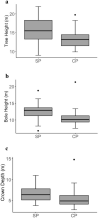Sleeping trees and sleep-related behaviours of the siamang (Symphalangus syndactylus) in a tropical lowland rainforest, Sumatra, Indonesia
- PMID: 32720108
- PMCID: PMC7813730
- DOI: 10.1007/s10329-020-00849-8
Sleeping trees and sleep-related behaviours of the siamang (Symphalangus syndactylus) in a tropical lowland rainforest, Sumatra, Indonesia
Abstract
Sleeping tree selection and related behaviours of a family group and a solitary female siamang (Symphalangus syndactylus) were investigated over a 5-month period in northern Sumatra, Indonesia. We performed all day follows, sleeping tree surveys and forest plot enumerations in the field. We tested whether: (1) physical characteristics of sleeping trees and the surrounding trees, together with siamang behaviours, supported selection based on predation risk and access requirements; (2) the preferences of a solitary siamang were similar to those of a family group; and (3) sleeping site locations within home ranges were indicative of home range defence, scramble competition with other groups or other species, or food requirements. Our data showed that (1) sleeping trees were tall, emergent trees with some, albeit low, connectivity to the neighbouring canopy, and that they were surrounded by other tall trees. Siamangs showed early entry into and departure from sleeping trees, and slept at the ends of branches. These results indicate that the siamangs' choice of sleeping trees and related behaviours were strongly driven by predator avoidance. The observed regular reuse of sleeping sites, however, did not support anti-predation theory. (2) The solitary female displayed selection criteria for sleeping trees that were similar to those of the family group, but she slept more frequently in smaller trees than the latter. (3) Siamangs selected sleeping trees to avoid neighbouring groups, monopolise resources (competition), and to be near their last feeding tree. Our findings indicate selectivity in the siamangs' use of sleeping trees, with only a few trees in the study site being used for this purpose. Any reduction in the availability of such trees might make otherwise suitable habitat unsuitable for these highly arboreal small apes.
Keywords: Gunung Leuser National Park; Hylobatidae; Leuser Ecosystem; Predation; Primate.
Figures





Similar articles
-
The role of anthropic, ecological, and social factors in sleeping site choice by long-tailed macaques (Macaca fascicularis).Am J Primatol. 2014 Dec;76(12):1140-50. doi: 10.1002/ajp.22299. Epub 2014 May 8. Am J Primatol. 2014. PMID: 24810544
-
Use of sleeping trees by ursine colobus monkeys (Colobus vellerosus) demonstrates the importance of nearby food.Primates. 2012 Jul;53(3):287-96. doi: 10.1007/s10329-012-0299-1. Epub 2012 Feb 19. Primates. 2012. PMID: 22350274
-
Clouded leopard predation on a wild juvenile siamang.Folia Primatol (Basel). 2010;81(6):362-8. doi: 10.1159/000324303. Epub 2011 Mar 31. Folia Primatol (Basel). 2010. PMID: 21454986
-
Silky Sifakas (Propithecus candidus) Use Sleep Sites for Thermoregulation, Food Access and Predator Avoidance.Folia Primatol (Basel). 2021;92(5-6):315-326. doi: 10.1159/000520710. Epub 2021 Nov 8. Folia Primatol (Basel). 2021. PMID: 34749372
-
The social structure and strategies of delphinids: predictions based on an ecological framework.Adv Mar Biol. 2007;53:195-294. doi: 10.1016/S0065-2881(07)53003-8. Adv Mar Biol. 2007. PMID: 17936137 Review.
Cited by
-
Sleeping site use of François' langurs (Trachypithecus francoisi) inhabiting limestone forest of Nonggang, southwest China: the importance of foraging efficiency.Primates. 2025 May;66(3):259-276. doi: 10.1007/s10329-025-01181-9. Epub 2025 Feb 21. Primates. 2025. PMID: 39982618
-
Measuring and modelling microclimatic air temperature in a historically degraded tropical forest.Int J Biometeorol. 2022 Jun;66(6):1283-1295. doi: 10.1007/s00484-022-02276-4. Epub 2022 Mar 31. Int J Biometeorol. 2022. PMID: 35357567 Free PMC article.
-
Spatiotemporal Patterns of Sleeping Site Use of Guinea Baboon Parties (Papio papio).Ecol Evol. 2025 Jul 27;15(7):e71610. doi: 10.1002/ece3.71610. eCollection 2025 Jul. Ecol Evol. 2025. PMID: 40718691 Free PMC article.
References
-
- Aldrich-Blake FP, Chivers DJ. On the genesis of a group of siamang. Am J Phys Anthropol. 1973;38:631–636. - PubMed
-
- Alexander C, Korstjens AH, Hankinson E, Usher G, Harrison N, Nowak MG, Abdullah A, Wich SA, Hill RA. Locating emergent trees in a tropical rainforest using data from an unmanned aerial vehicle (UAV) Int J Appl Earth Obs. 2018;72:86–90.
-
- Anderson JR. Ethology and ecology of sleep in monkeys and apes. Adv Stud Behav. 1984;14:165–229.
-
- Anderson JR. Sleep, sleeping sites, and sleep-related activities: awakening to their significance. Am J Primatol. 1998;46:63–75. - PubMed
-
- Anderson JR. Sleep-related behavioural adaptations in free-ranging anthropoid primates. Sleep Med Rev. 2000;4:355–373. - PubMed
MeSH terms
LinkOut - more resources
Full Text Sources

